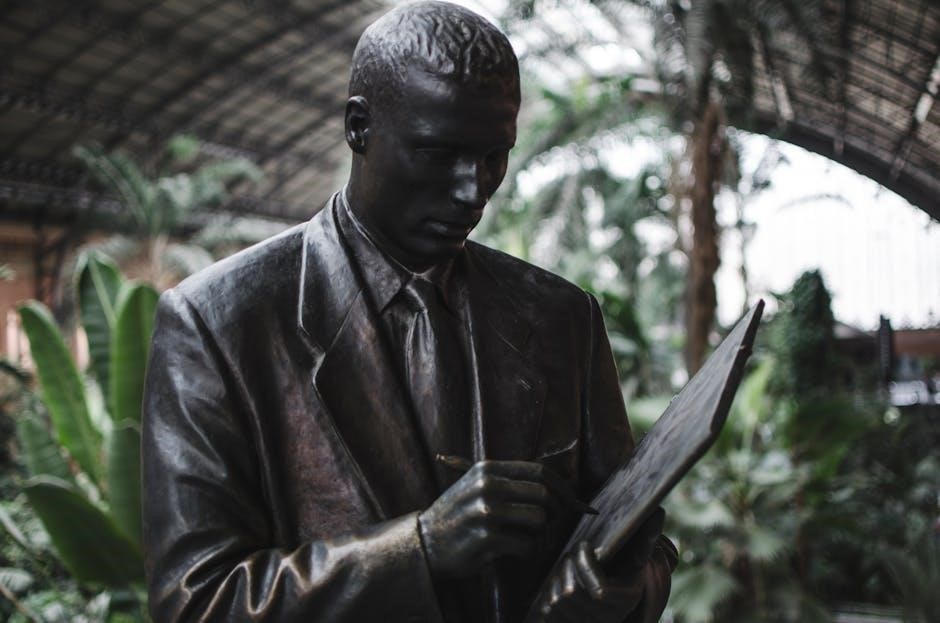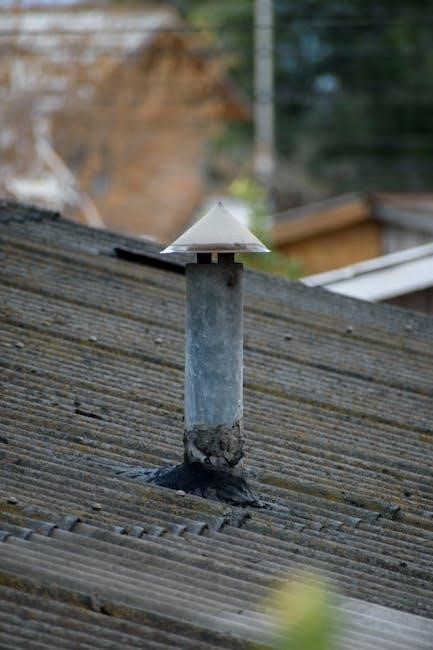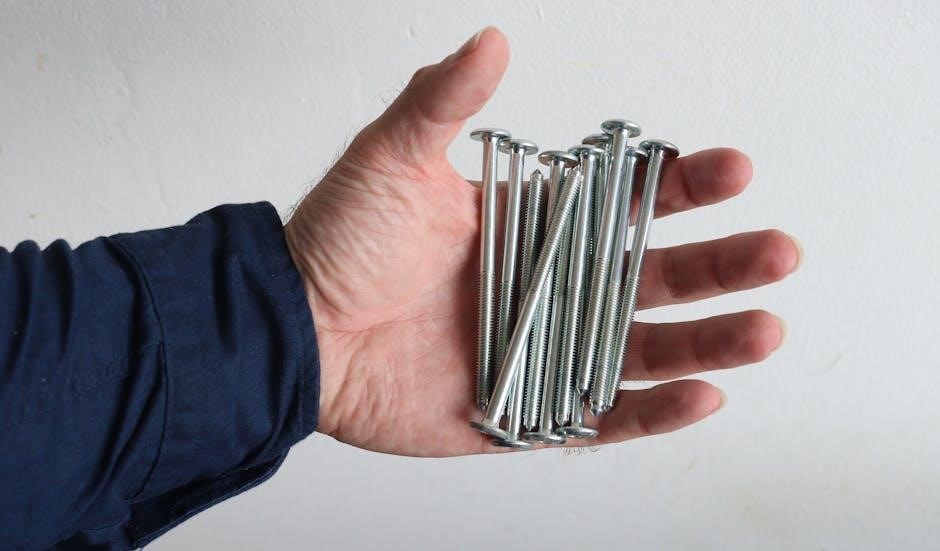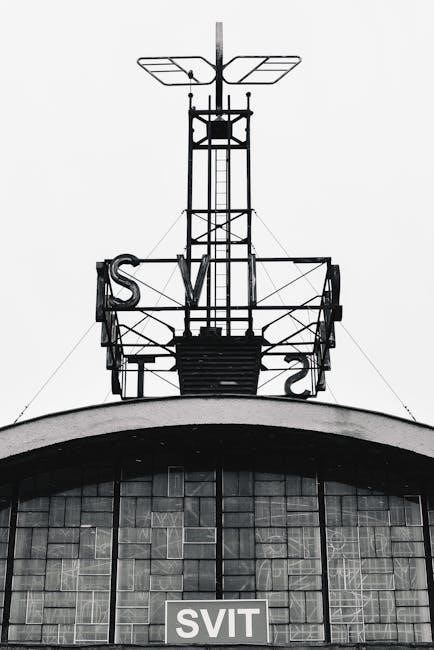Metal roof installation offers durability, weather resistance, and energy efficiency. This guide provides a comprehensive overview of the benefits, key steps, and proper techniques for a successful metal roofing project.
1.1 Overview of Metal Roofing Benefits
Metal roofing offers exceptional durability, lasting 30 to 50 years or more, and provides superior resistance to weather, fire, and pests. Its sleek design enhances curb appeal while reducing maintenance needs. Energy-efficient options, like reflective coatings, lower heating and cooling costs. Metal roofs are lightweight, reducing structural stress, and can be installed over existing roofs, saving removal costs. They are also environmentally friendly, as many are made from recycled materials and are fully recyclable at the end of their life. With various styles and colors available, metal roofing suits diverse architectural designs, making it a versatile and sustainable choice for homeowners and businesses alike.
1.2 Importance of Proper Installation
Proper installation is critical to ensure the longevity and performance of a metal roof. Improper techniques can lead to leaks, structural damage, and reduced lifespan. Adequate training and adherence to manufacturer guidelines are essential to avoid common mistakes. Secure fastening, precise alignment, and proper sealing prevent water infiltration and ensure weather-tightness. Additionally, correct installation enhances safety by preventing panel displacement during harsh weather conditions. A well-installed metal roof maximizes energy efficiency and aesthetic appeal, providing long-term value and protection for the building. Therefore, hiring experienced professionals or following detailed installation manuals is crucial to achieve a successful, durable roofing system.
Pre-Installation Preparation
Pre-installation preparation involves site evaluation, safety measures, and organizing tools and materials. Accurate measurements and detailed planning ensure a smooth and efficient installation process.
2.1 Site Preparation and Safety Measures
Proper site preparation and safety measures are essential before starting metal roof installation. Clear the area of debris and obstacles to ensure easy access and prevent accidents. Conduct a thorough inspection of the roof structure to identify any weak points or potential hazards.
Safety equipment, such as harnesses, hard hats, and slip-resistant footwear, must be worn by all workers. Ensure proper scaffolding is erected and regularly inspected to maintain stability. Secure power tools and materials to avoid dropping them from heights.
Install warning signs and barriers to restrict unauthorized access to the site. Keep a first aid kit on hand and ensure all team members are trained in emergency procedures. Adhere to local building codes and safety regulations throughout the preparation process.
Weather conditions, such as strong winds or rain, can pose significant risks. Schedule installation during favorable weather and monitor forecasts to avoid unsafe working conditions. Proper planning and adherence to safety protocols ensure a secure and efficient installation process.
2.2 Tools and Materials Required
Installing a metal roof requires specific tools and materials to ensure a successful and durable outcome. Essential tools include a cordless drill, impact wrench, metal snips, tape measure, chalk line, and a utility knife. Safety gear, such as gloves, safety glasses, and a harness, is also crucial for protection during the process.
Key materials needed are metal roofing panels, roof screws, washers, flashing, and underlayment. Additional components may include eave trim, ridge caps, and foam closures. Ensure all materials are compatible with your specific roof type and climate conditions.

Verify the quality and quantity of materials before starting. Organize tools and supplies near the work area for efficiency. Always follow manufacturer recommendations for tools and materials to maintain warranty validity and ensure a professional finish.
Properly storing unused materials will prevent damage and extend their lifespan. Double-check measurements and layouts to minimize waste and ensure accurate installation. A well-prepared workspace and inventory are foundational to a smooth metal roof installation process.
2.3 Measuring and Planning the Roof Layout
Accurate measurements and a well-planned layout are critical for a successful metal roof installation. Begin by measuring the roof’s length, width, and pitch to determine the number of panels and materials needed. Use a tape measure and chalk line to mark the roof’s dimensions and identify key reference points.
Calculate the number of panels required, considering factors like overlap and fastener spacing. Ensure the layout accounts for roof features such as vents, skylights, and chimneys. Create a detailed sketch to visualize panel placement and avoid errors during installation.
Verify measurements against the manufacturer’s specifications to ensure compatibility. Double-check for any obstacles or irregularities that may affect the layout. A precise plan minimizes waste and ensures a professional finish, making the installation process efficient and stress-free.

Organize the panels and components in the planned sequence to maintain workflow consistency. Proper planning ensures a secure and aesthetically pleasing metal roof installation.

Installing Roofing Components
Install eave trim, metal panels, and flashing to ensure weather-tightness. Secure panels with screws, aligning ribs and seams. Apply sealants at joints and valleys for added protection. Follow manufacturer guidelines for precise fitting and safety.
3.1 Eave Trim Installation
Eave trim is installed along the roof’s edge to cover wall sheeting and ensure proper panel alignment. Measure and cut the trim to fit the roof’s perimeter, securing it with fasteners. Align the trim with the roof’s edge, leaving a 1/8-inch clearance for wall panels. Ensure the trim is level and securely attached to prevent gaps. Use anti-siphoning channels to direct water away from the structure, enhancing weather protection. Avoid over-tightening fasteners to allow for thermal expansion. Proper installation ensures a smooth transition between the roof and walls, promoting durability and a finished appearance. Follow manufacturer guidelines for specific trim styles and materials to maintain warranty and structural integrity. This step is crucial for achieving a weather-tight seal and a professional-looking roof installation. Inspect the trim for alignment and security before proceeding to the next steps.
3.2 Laying and Securing Metal Panels
Begin by placing the first metal panel along the eave trim, ensuring it fits snugly. Align the panel with the roof’s edge and secure it using the recommended screw pattern. Fasten screws at intervals specified in the manufacturer’s guidelines to avoid over-tightening, which can damage the panel. Use foam closures to seal gaps between panels and the eave trim, ensuring weather-tightness. For subsequent panels, overlap them according to the manufacturer’s instructions, typically 1-2 inches, and secure with fasteners. Ensure proper alignment with the roof’s slope and check for levelness. Leave expansion joints between panels to accommodate thermal movement. After laying all panels, inspect the entire roof to verify alignment and tighten any loose fasteners. Properly securing panels is critical to prevent leaks, warping, or detachment during harsh weather conditions. Always refer to the manufacturer’s installation manual for specific panel types and fastening requirements. This step ensures a sturdy and long-lasting metal roof system. Regularly check for any gaps or misalignments during installation. Follow all safety protocols to avoid injuries or damage to the panels. Secure panels firmly but avoid over-tightening, as this can cause deformation. Ensure all edges are properly sealed to maintain the roof’s integrity. Proper installation of panels is essential for achieving a durable and weather-resistant roof. Verify that all fasteners are correctly spaced and tightened to prevent future issues. This step is crucial for ensuring the roof’s structural integrity and aesthetic appeal. Always follow the manufacturer’s guidelines for specific panel types and installation methods. Inspect the panels regularly during installation to ensure they are properly aligned and secured. This ensures a professional finish and long-lasting performance of the metal roof. Regularly check for any gaps or misalignments during installation. Follow all safety protocols to avoid injuries or damage to the panels. Properly securing panels is critical to prevent leaks, warping, or detachment during harsh weather conditions. Always refer to the manufacturer’s installation manual for specific panel types and fastening requirements. This step ensures a sturdy and long-lasting metal roof system. Proper installation of panels is essential for achieving a durable and weather-resistant roof. Verify that all fasteners are correctly spaced and tightened to prevent future issues. This step is crucial for ensuring the roof’s structural integrity and aesthetic appeal. Always follow the manufacturer’s guidelines for specific panel types and installation methods. Inspect the panels regularly during installation to ensure they are properly aligned and secured. This ensures a professional finish and long-lasting performance of the metal roof. Regularly check for any gaps or misalignments during installation. Follow all safety protocols to avoid injuries or damage to the panels. Properly securing panels is critical to prevent leaks, warping, or detachment during harsh weather conditions. Always refer to the manufacturer’s installation manual for specific panel types and fastening requirements. This step ensures a sturdy and long-lasting metal roof system. Proper installation of panels is essential for achieving a durable and weather-resistant roof. Verify that all fasteners are correctly spaced and tightened to prevent future issues. This step is crucial for ensuring the roof’s structural integrity and aesthetic appeal. Always follow the manufacturer’s guidelines for specific panel types and installation methods. Inspect the panels regularly during installation to ensure they are properly aligned and secured. This ensures a professional finish and long-lasting performance of the metal roof. Regularly check for any gaps or misalignments during installation. Follow all safety protocols to avoid injuries or damage to the panels. Properly securing panels is critical to prevent leaks, warping, or detachment during harsh weather conditions. Always refer to the manufacturer’s installation manual for specific panel types and fastening requirements. This step ensures a sturdy and long-lasting metal roof system. Proper installation of panels is essential for achieving a durable and weather-resistant roof. Verify that all fasteners are correctly spaced and tightened to prevent future issues. This step is crucial for ensuring the roof’s structural integrity and aesthetic appeal. Always follow the manufacturer’s guidelines for specific panel types and installation methods. Inspect the panels regularly during installation to ensure they are properly aligned and secured. This ensures a professional finish and long-lasting performance of the metal roof. Regularly check for any gaps or misalignments during installation. Follow all safety protocols to avoid injuries or damage to the panels. Properly securing panels is critical to prevent leaks, warping, or detachment during harsh weather conditions. Always refer to the manufacturer’s installation manual for specific panel types and fastening requirements. This step ensures a sturdy and long-lasting metal roof system. Proper installation of panels is essential for achieving a durable and weather-resistant roof. Verify that all fasteners are correctly spaced and tightened to prevent future issues. This step is crucial for ensuring the roof’s structural integrity and aesthetic appeal. Always follow the manufacturer’s guidelines for specific panel types and installation methods. Inspect the panels regularly during installation to ensure they are properly aligned and secured. This ensures a professional finish and long-lasting performance of the metal roof. Regularly check for any gaps or misalignments during installation. Follow all safety protocols to avoid injuries or damage to the panels. Properly securing panels is critical to prevent leaks, warping, or detachment during harsh weather conditions. Always refer to the manufacturer’s installation manual for specific panel types and fastening requirements. This step ensures a sturdy and long-lasting metal roof system. Proper installation of panels is essential for achieving a durable and weather-resistant roof. Verify that all fasteners are correctly spaced and tightened to prevent future issues. This step is crucial for ensuring the roof’s structural integrity and aesthetic appeal. Always follow the manufacturer’s guidelines for specific panel types and installation methods. Inspect the panels regularly during installation to ensure they are properly aligned and secured. This ensures a professional finish and long-lasting performance of the metal roof. Regularly check for any gaps or misalignments during installation. Follow all safety protocols to avoid injuries or damage to the panels. Properly securing panels is critical to prevent leaks, warping, or detachment during harsh weather conditions. Always refer to the manufacturer’s installation manual for specific panel types and fastening requirements. This step ensures a sturdy and long-lasting metal roof system. Proper installation of panels is essential for achieving a durable and weather-resistant roof. Verify that all fasteners are correctly spaced and tightened to prevent future issues. This step is crucial for ensuring the roof’s structural integrity and aesthetic appeal. Always follow the manufacturer’s guidelines for specific panel types and installation methods. Inspect the panels regularly during installation to ensure they are properly aligned and secured. This ensures a professional finish and long-lasting performance of the metal roof. Regularly check for any gaps or misalignments during installation. Follow all safety protocols to avoid injuries or damage to the panels. Properly securing panels is critical to prevent leaks, warping, or detachment during harsh weather conditions. Always refer to the manufacturer’s installation manual for specific panel types and fastening requirements. This step ensures a sturdy and long-lasting metal roof system. Proper installation of panels is essential for achieving a durable and weather-resistant roof. Verify that all fasteners are correctly spaced and tightened to prevent future issues. This step is crucial for ensuring the roof’s structural integrity and aesthetic appeal. Always follow the manufacturer’s guidelines for specific panel types and installation methods. Inspect the panels regularly during installation to ensure they are properly aligned and secured. This ensures a professional finish and long-lasting performance of the metal roof. Regularly check for any gaps or misalignments during installation. Follow all safety protocols to avoid injuries or damage to the panels. Properly securing panels is critical to prevent leaks, warping, or detachment during harsh weather conditions. Always refer to the manufacturer’s installation manual for specific panel types and fastening requirements; This step ensures a sturdy and long-lasting metal roof system. Proper installation of panels is essential for achieving a durable and weather-resistant roof. Verify that all fasteners are correctly spaced and tightened to prevent future issues. This step is crucial for ensuring the roof’s structural integrity and aesthetic appeal. Always follow the manufacturer’s guidelines for specific panel types and installation methods. Inspect the panels regularly during installation to ensure they are properly aligned and secured. This ensures a professional finish and long-lasting performance of the metal roof. Regularly check for any gaps or misalignments during installation. Follow all safety protocols to avoid injuries or damage to the panels. Properly securing panels is critical to prevent leaks, warping, or detachment during harsh weather conditions. Always refer to the manufacturer’s installation manual for specific panel types and fastening requirements. This step ensures a sturdy and long-lasting metal roof system. Proper installation of panels is essential for achieving a durable and weather-resistant roof. Verify that all fasteners are correctly spaced and tightened to prevent future issues. This step is crucial for ensuring the roof’s structural integrity and aesthetic appeal. Always follow the manufacturer’s guidelines for specific

Final Inspection and Maintenance
3.3 Flashing and Sealant Application
Flashing and sealant application are critical for ensuring a watertight metal roof. Start by identifying areas requiring flashing, such as vents, chimneys, and roof valleys. Use pre-formed flashing or fabricate it from metal, ensuring it matches the roof’s material. Apply a thin layer of rubber-based sealant to the underside of the flashing before securing it with screws or rivets. Tighten fasteners firmly but avoid over-tightening, which can compromise the seal. For seams and overlaps, apply a bead of high-quality silicone or polyurethane sealant, spreading it evenly with a caulking tool. Ensure all edges and joints are properly sealed to prevent water infiltration. Regularly inspect flashing and sealants during and after installation to address any gaps or weaknesses. Proper flashing and sealant application are essential for maintaining the roof’s integrity and preventing leaks. Always follow manufacturer guidelines for specific products and installation methods. This step ensures long-term durability and weather resistance of the metal roof system.